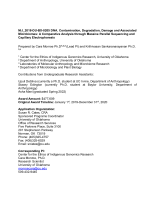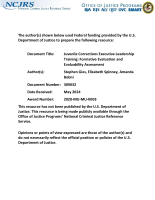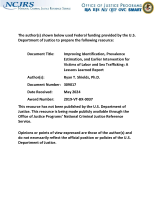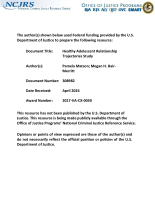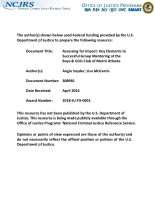Research and development
Multidisciplinary Threat Assessment and Management Teams in Practice: Common Elements and Operations of Community Based MTAMTs
What You Can’t Buy, Can’t Kill You
Forensic Science Failure Mode And Effects Analysis Application
Rheological Behavior of Brain Tissue: Experiments vs Theory and Forensic Applications
Evaluation of Heat Flux Profiles Through Walls in Support of Fire Model Validation
DNA Contamination, Degradation, Damage and Associated Microbiomes: A Comparative Analysis through Massive Parallel Sequencing and Electrophoresis
NIJ FY24 Invited to Apply – Safe Transitions for Teens: Assessing the Impact of Intimate Partner Transitional Housing on Adolescent Residents Study
NIJ FY24 Domestic Radicalization and Violent Extremism - Invited to Apply
Graphic Description – Medicolegal Death Investigation Frequently Used Data Elements For Toxicology And Seized Drugs
Juvenile Corrections Executive Leadership Training: Formative Evaluation and Evaluability Assessment
Improving Identification, Prevalence Estimation, and Earlier Intervention for Victims of Labor and Sex Trafficking: A Lessons Learned Report
NIJ FY 2022 Invited to Apply - Funding to Support the Research and Development in Forensic Science for Criminal Justice Purposes Program
NIJ FY 2023 Invited to Apply - Funding to Support the Research and Development in Forensic Science for Criminal Justice Purposes Program
Drug-Impaired Driving: The Contribution of Emerging and Undertested Drugs
Victimized Teachers’ Perceptions of Procedural Justice and the Impact on Satisfaction with School Responses
Creating a Process for Equitable Action to Prevent School and Community Violence
Healthy Adolescent Relationship Trajectories Study
Assessing for Impact: Key Elements to Successful Group Mentoring at the Boys & Girls Club of Metro Atlanta
Forensic DNA Interpretation and Human Factors: Improving Practice Through a Systems Approach
Unconventional Wisdom: Research Shakes Up Assumptions About Sex Trafficking Clues in Online Escort Ads
Scientific study finds that many widely recognized indicators of trafficking in online escort ads are likely not reliable. Research also produces new practice guide.
Closing Cases Using Gunshot Residue
Not every crime scene will have definitive evidence, such as DNA, to link an individual to a crime. In those cases, law enforcement relies on other evidence to build the burden of proof. NIJ graduate research fellow Dr. Shelby Khandasammy developed a tool to analyze organic gunshot residue and distinguish between different firearms calibers and manufacturers. She joins Marie Garcia, office director for the Office of Criminal Justice Systems at NIJ, to talk about her work and experience as a research fellow.




